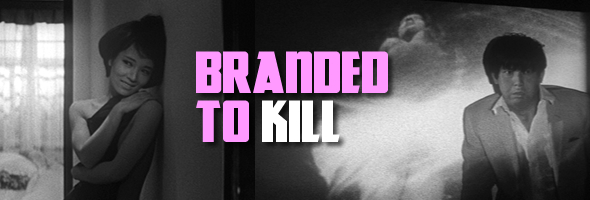
B&W, 1967, 91m.
Directed by Seijun Suzuki
Starring Jô Shishido, Kôji Nanbara, Isao Tamagawa, Anne Mari
Arrow (Blu-Ray & DVD) (US RB/R2 HD), Criterion (Blu-Ray & DVD) (US RA/R1 HD) / WS (2.35:1) (16:9)

B&W, 1967, 91m.
Directed by Seijun Suzuki
Starring Jô Shishido, Kôji Nanbara, Isao Tamagawa, Anne Mari
Arrow (Blu-Ray & DVD) (US RB/R2 HD), Criterion (Blu-Ray & DVD) (US RA/R1 HD) / WS (2.35:1) (16:9)
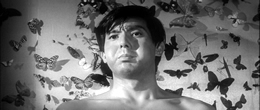 Hired assassin Hanada Goro (puffy-cheeked Shishido) has a lot of problems. His career as Killer #3 is in jeopardy from stiff competition and uncooperative targets, he can't get over his fetish for the smell of boiling rice, and a strange girl obsessed with dead birds keeps showing up to perplex him for no discernable reason. When his own wife gets hired against him, he careens to a final showdown with the mysterious number one assassin in his organization.
Hired assassin Hanada Goro (puffy-cheeked Shishido) has a lot of problems. His career as Killer #3 is in jeopardy from stiff competition and uncooperative targets, he can't get over his fetish for the smell of boiling rice, and a strange girl obsessed with dead birds keeps showing up to perplex him for no discernable reason. When his own wife gets hired against him, he careens to a final showdown with the mysterious number one assassin in his organization.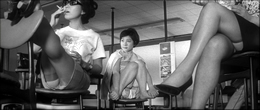
A dizzy, thoroughly wacko hitman yarn, Branded to Kill (Koroshi no rakuin) got Suzuki fired from Toho after execs saw the finished print -- with good reason. Shot in stark, noirish black and white and crammed from start to finish with goofy visual ideas, the film bears little resemblance to anything else in cinema. Of course, viewer taste will completely dictate a response to this film, which has received both acclaim and disdain since its resurrection from Criterion. At the very least, hardcore foreign film buffs owe it to themselves to check this out and discover a completely unique style of filmmaking.
The hits themselves are riotous exercises in black comic timing, with one funny homage to From Russia with Love that goes memorably haywire into Spy vs. Spy territory. The film also proved to be the last straw for Nikkatsu, the studio where director Seijun Suzuki cranked out over forty films. The increasingly extreme nature of his "nonsensical" 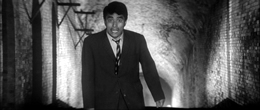 films was proving to be too much, and after this one (which also pushes the nudity quotient surprisingly high for '67), they let him go. Unbelievably, he went to helm a loose sequel to this film, Pistol Opera, in 2001.
films was proving to be too much, and after this one (which also pushes the nudity quotient surprisingly high for '67), they let him go. Unbelievably, he went to helm a loose sequel to this film, Pistol Opera, in 2001.
Like Suzuki's Tokyo Drifter, this film was one of the key entries in Criterion's early push to introduce western audiences to the wilder extremes of classic Japanese genre cinema. Their laserdisc was something of a hot item despite severe cropping of the frame and a drab, overpumped appearance, and the same framing carried over to their first non-anamorphic DVD release in 1999 which also included a lengthy 1997 interview with Suzuki about the film's creation and controversial reception. The much-needed HD  reissue of the film from Criterion in 2011 features a greatly improved transfer with much sharper detail, and the Blu-Ray edition in particular reveals countless little textures and compositional details obscured by the limitations of SD. The framing is also corrected here and amusingly gives Shishido a case of the "Cinemascope mumps" in a few shots for good measure. Also included is a new video featurette with Suzuki and assistant director Masami Kuzuu, who separately discuss the making of the film including the breakneck Nikkatsu production schedules which would probably have driven most people insane. Shishido also appears for a new 10-minute interview in which he hilariously recounts getting cosmetic work on his cheeks, discovering his skill at playing killers, and experiencing the difficulties of adhesive covering during sex scenes. Other extras include the theatrical trailer and a strikingly-designed booklet containing a new essay about the film, "Reductio Ad Absurdum" by critic Tony Rayns.
reissue of the film from Criterion in 2011 features a greatly improved transfer with much sharper detail, and the Blu-Ray edition in particular reveals countless little textures and compositional details obscured by the limitations of SD. The framing is also corrected here and amusingly gives Shishido a case of the "Cinemascope mumps" in a few shots for good measure. Also included is a new video featurette with Suzuki and assistant director Masami Kuzuu, who separately discuss the making of the film including the breakneck Nikkatsu production schedules which would probably have driven most people insane. Shishido also appears for a new 10-minute interview in which he hilariously recounts getting cosmetic work on his cheeks, discovering his skill at playing killers, and experiencing the difficulties of adhesive covering during sex scenes. Other extras include the theatrical trailer and a strikingly-designed booklet containing a new essay about the film, "Reductio Ad Absurdum" by critic Tony Rayns.
In 2014, Arrow Films brought the title to the UK with an equally superb, virtually identical HD presentation on its Blu-ray version (packed as a dual-format release with the DVD) as well as a different slate of extras. A fun 6-minute 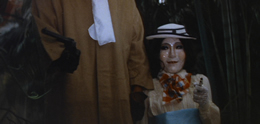 2001 piece with a heavily-smoking Shishido covers the aesthetic behind the sex scenes (taken from Degas), the film's hostile reception from its studio, and the director's apparent lack of sleep during the production. Nikkatsu liner notes mainstay Jasper Sharp chimes in with his usual expert overview of the film and the state of the studio at the time, too. Of course, Suzuki is represented as well with a 7-minute interview from the same locale and year in which he runs through the shared screenplay and its submission to the studio, casting, filming locations, and the censorship issues involving the daring levels of bare flesh.
2001 piece with a heavily-smoking Shishido covers the aesthetic behind the sex scenes (taken from Degas), the film's hostile reception from its studio, and the director's apparent lack of sleep during the production. Nikkatsu liner notes mainstay Jasper Sharp chimes in with his usual expert overview of the film and the state of the studio at the time, too. Of course, Suzuki is represented as well with a 7-minute interview from the same locale and year in which he runs through the shared screenplay and its submission to the studio, casting, filming locations, and the censorship issues involving the daring levels of bare flesh.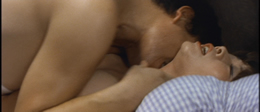
However, the biggest draw here is Trapped in Lust, an entire bonus feature film. Shot in 1973, it's a mad offering from director Atsushi Yamatoya (who co-wrote Branded with this film's screenwriter, Yozo Tanaka) with the concept of the main feature tweaked into a funky roman porno. It looks considerably cheaper than the preceding film and runs much shorter (73 minutes), with fleshy sex scenes taking up at least half of the running time (including one memorable orgy scene involving rock music, a room full of geishas, and a bottle of booze). There's also a creepy mob killer dressed up as a little porcelain girl complete with a squeaky voice and a sick fondness for bathroom plungers, wailing sax music that'll drive you crazy, and bell bottoms aplenty as "Hitman Hoshi" (Genjiro Arato) navigates a maze of people trying to kill and women who can't resist falling into his arms. One scene has has a bit of uncensored frontal female nudity in one scene, a real rarity at the time. The transfer looks about on par for other mid-'70s Nikkatsu video releases (presumably bumped up from SD), meaning it looks pretty good though not as impressive as Branded for obvious reasons. The trailer for this film is included as well. Absolutely crazy stuff and worth the purchase of the set all by itself.
![]()